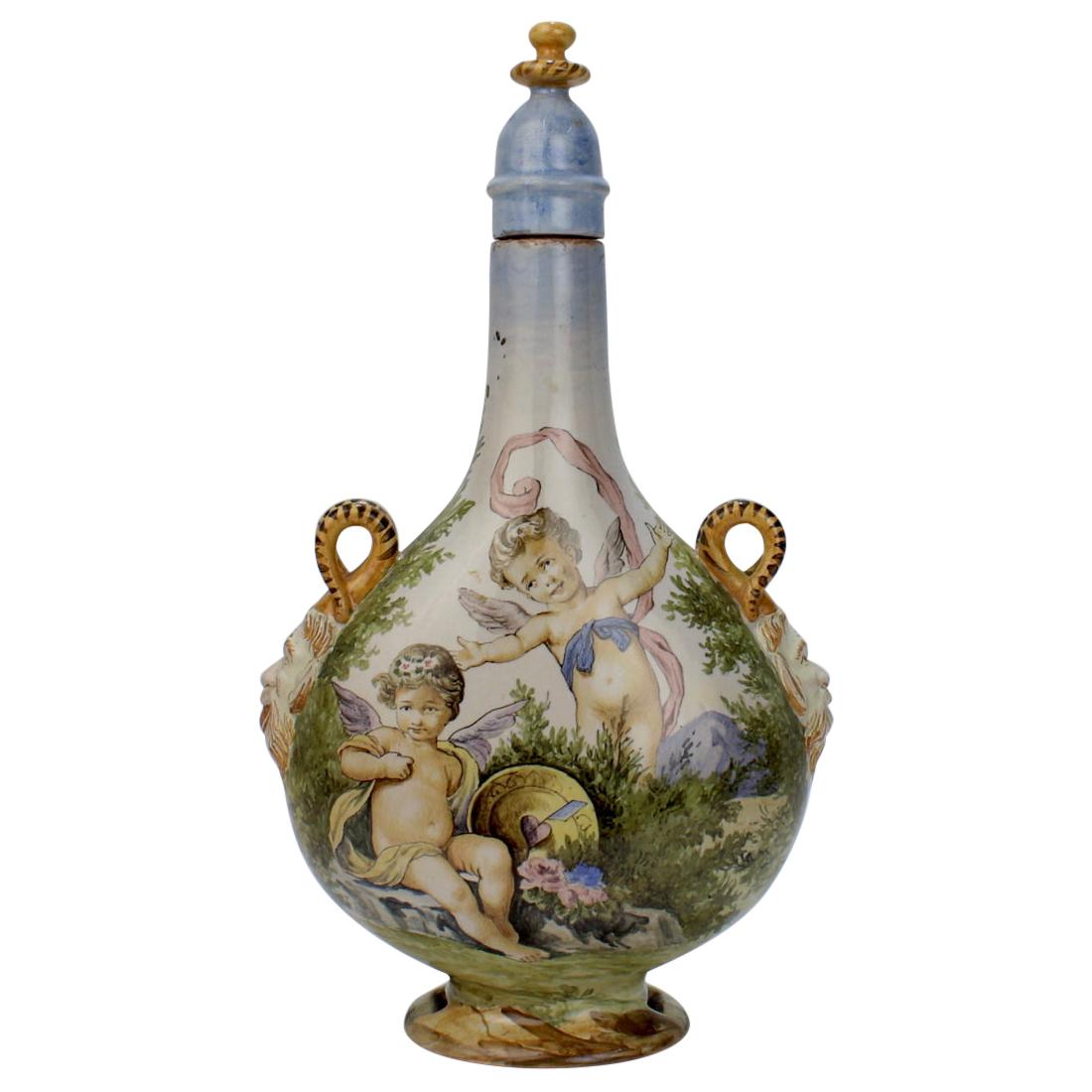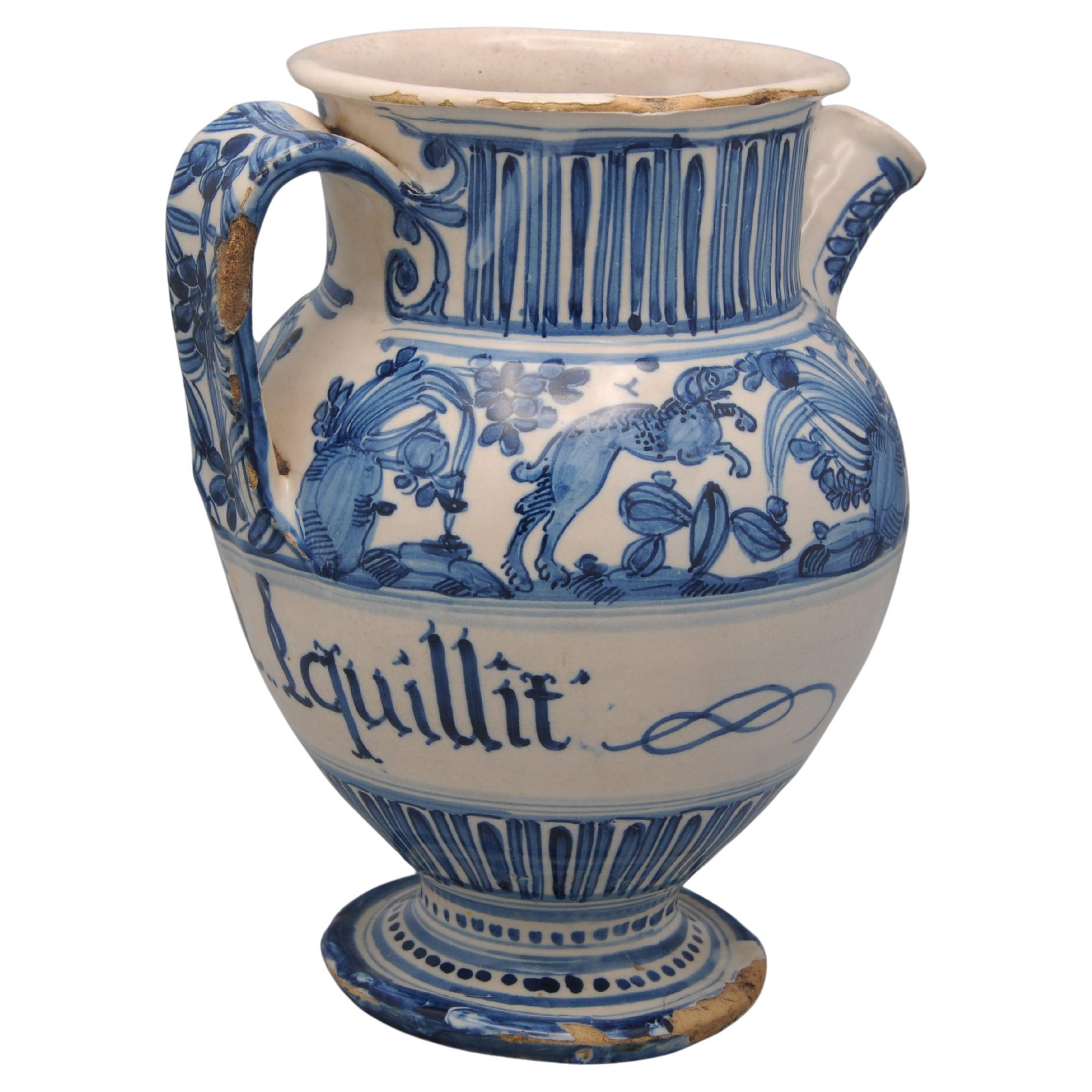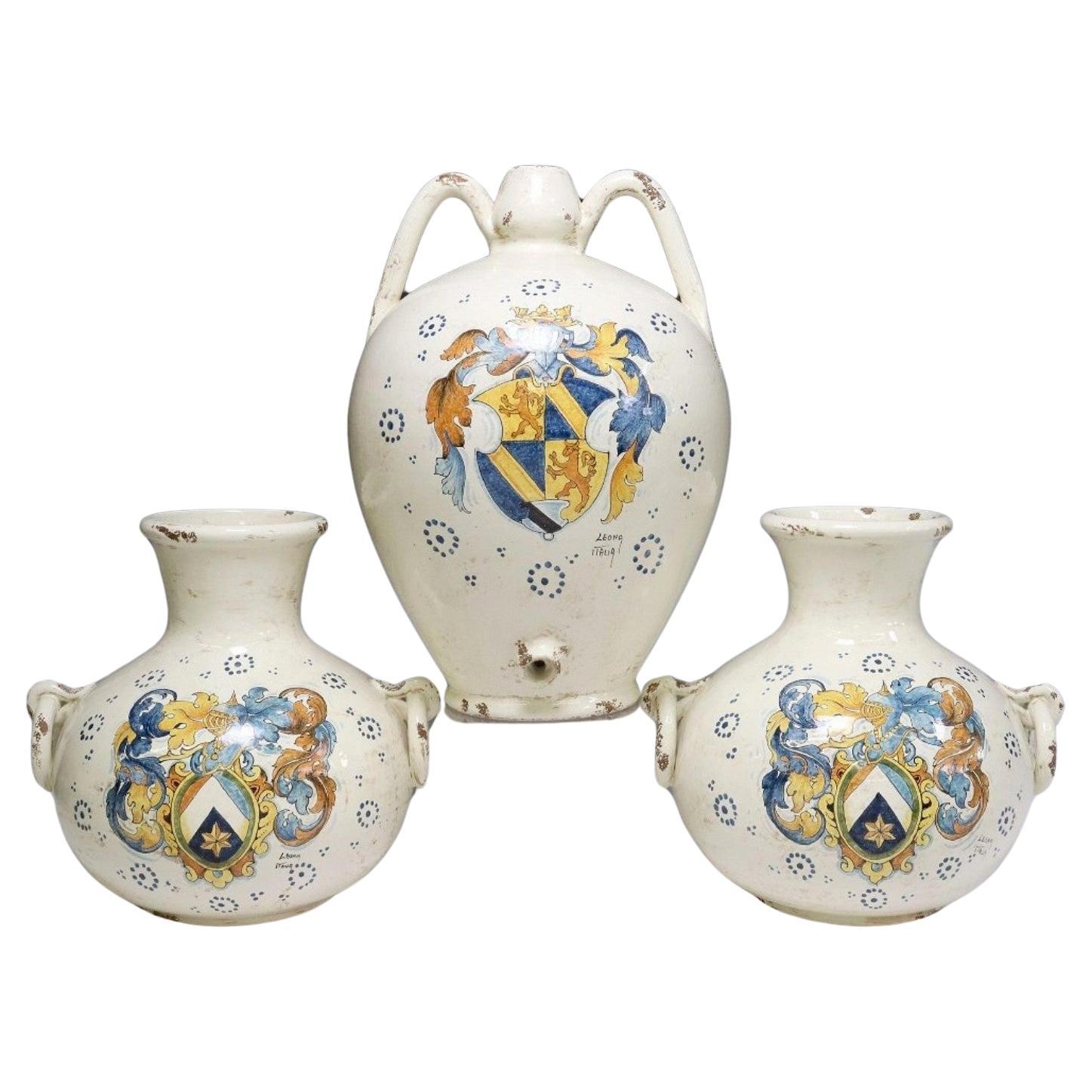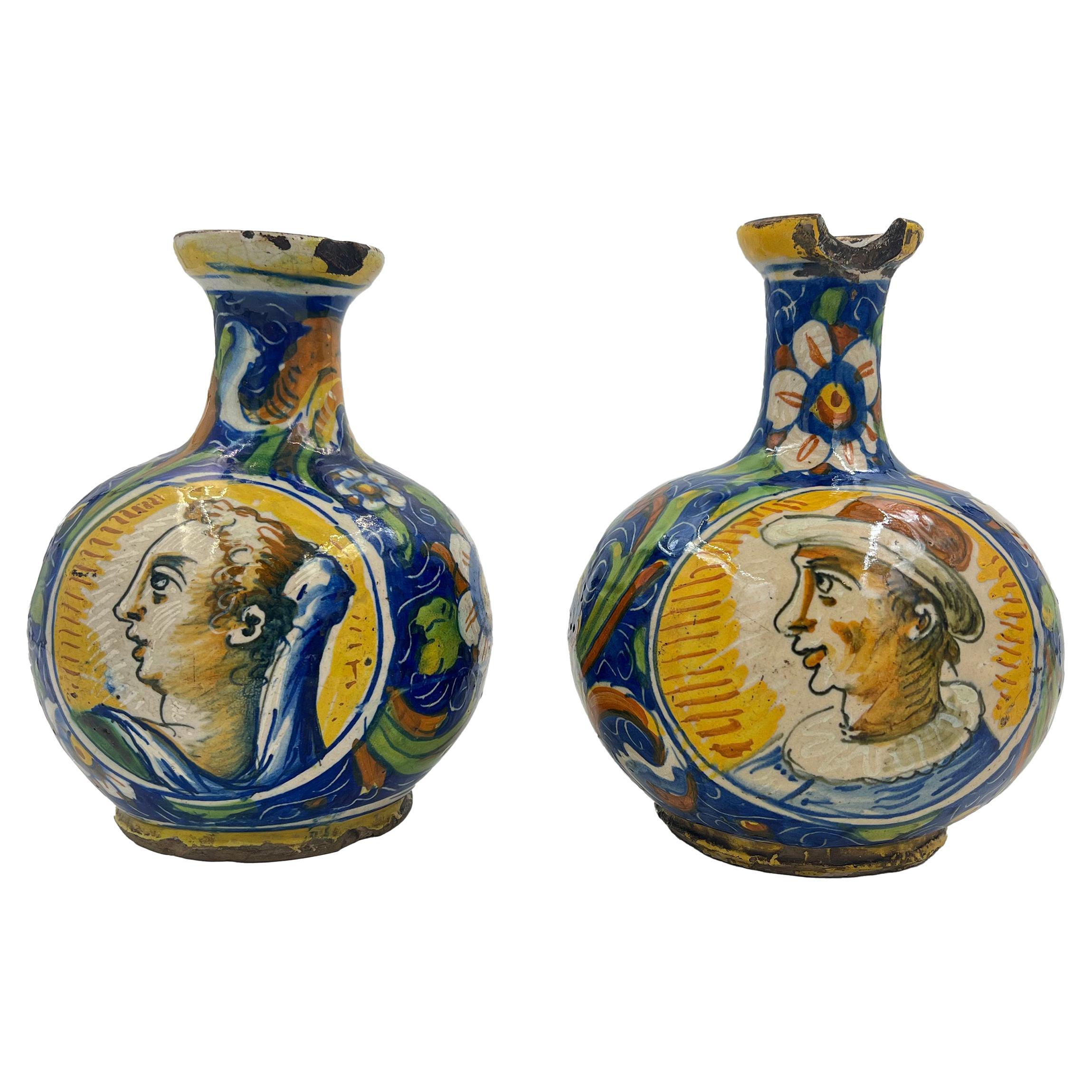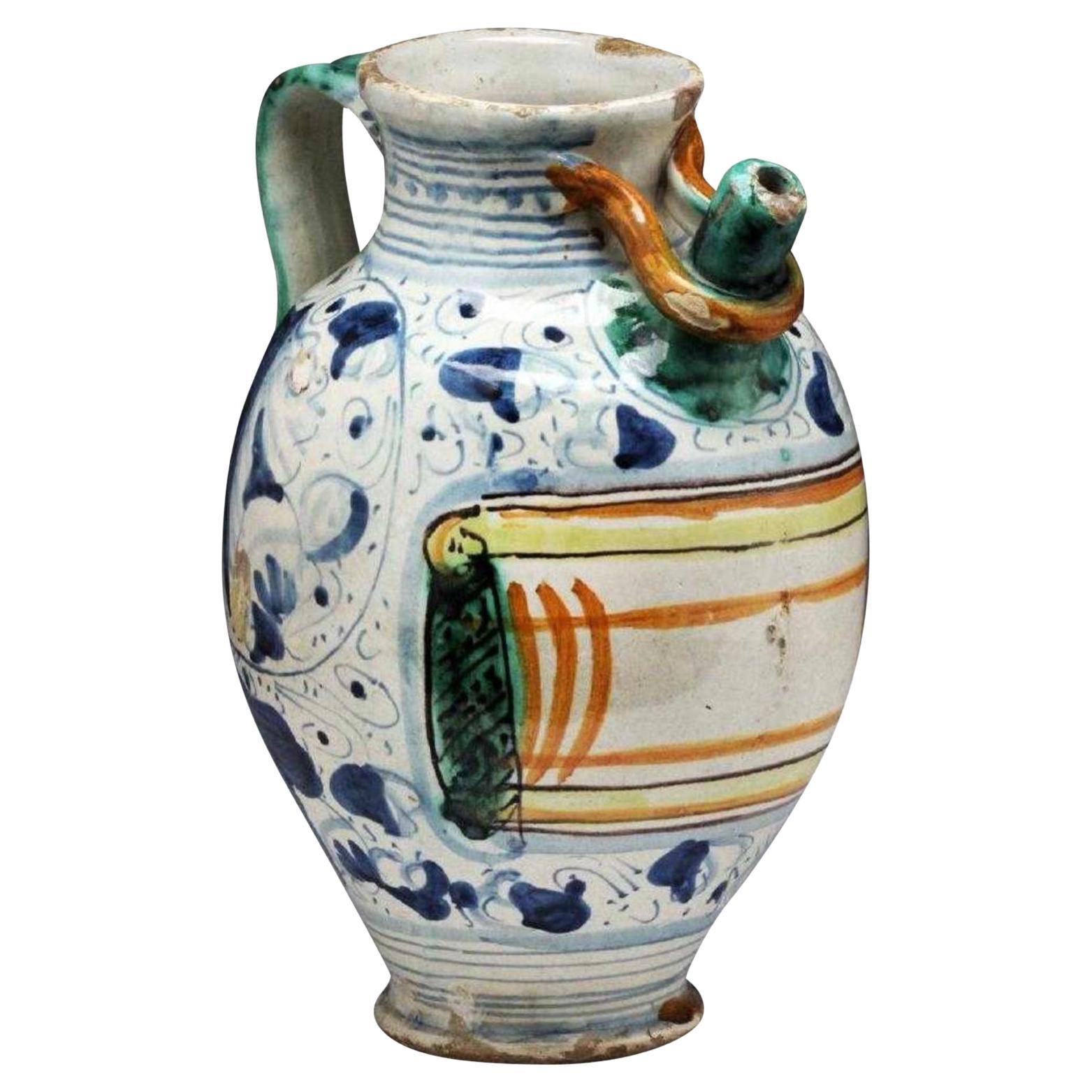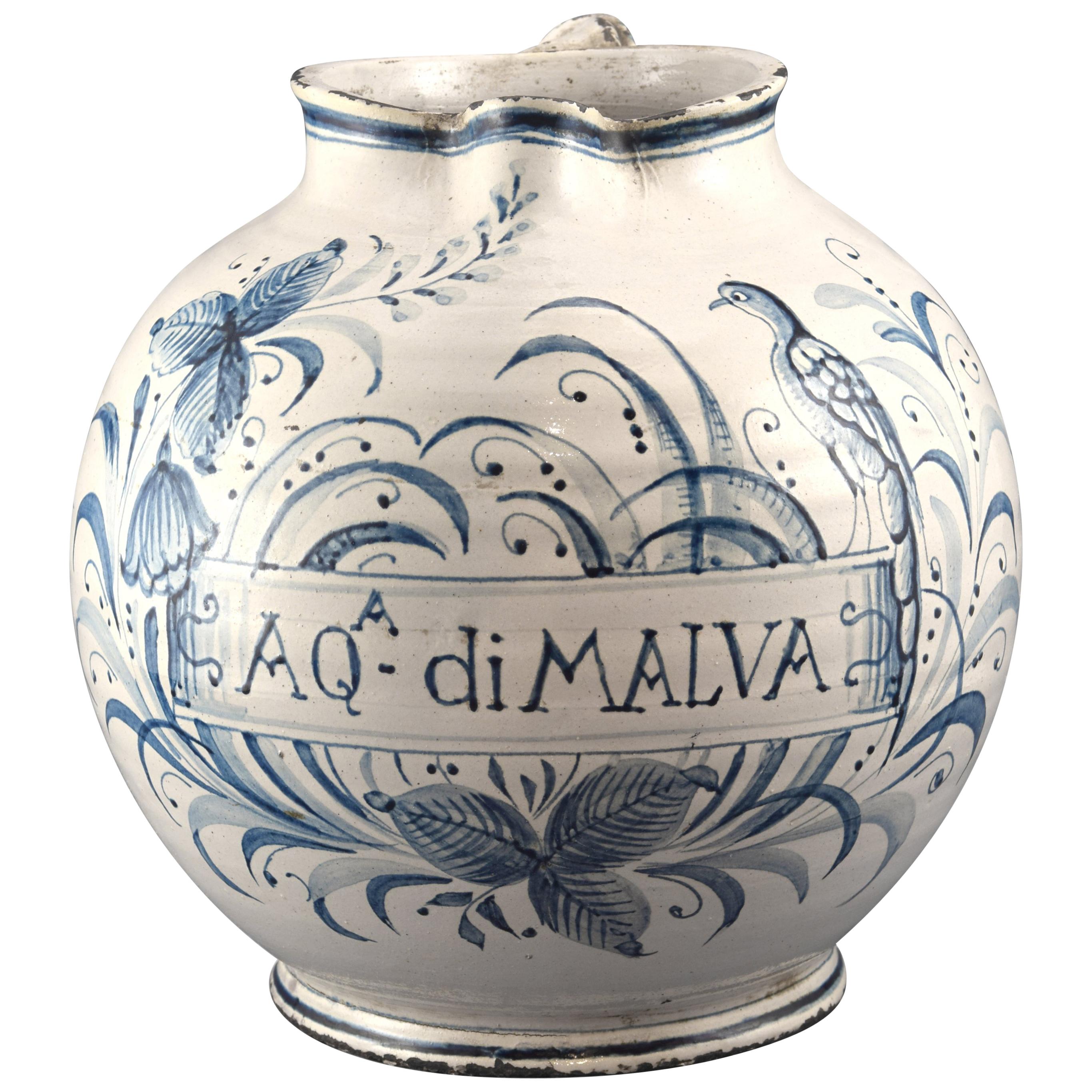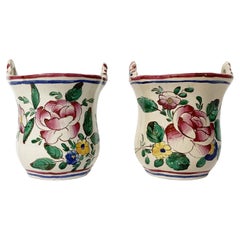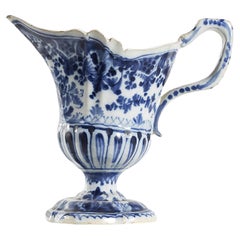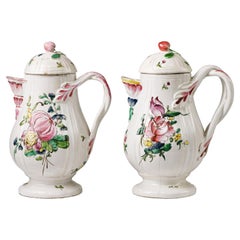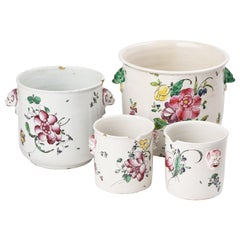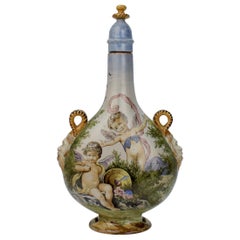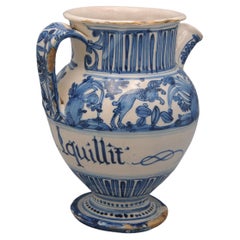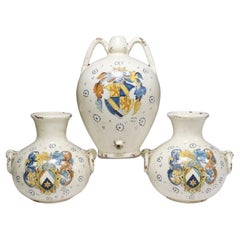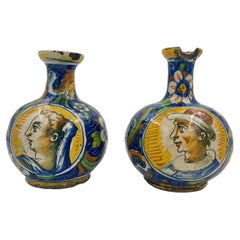Items Similar to Italian Maiolica Pharmacy Flasks Felice Clerici, Milan Circa 1770-1780
Video Loading
Want more images or videos?
Request additional images or videos from the seller
1 of 22
Italian Maiolica Pharmacy Flasks Felice Clerici, Milan Circa 1770-1780
$6,595.48per set
£4,906.37per set
€5,500per set
CA$9,031.47per set
A$10,041.77per set
CHF 5,243.26per set
MX$122,232.79per set
NOK 66,901.69per set
SEK 62,683.68per set
DKK 41,868.46per set
Shipping
Retrieving quote...The 1stDibs Promise:
Authenticity Guarantee,
Money-Back Guarantee,
24-Hour Cancellation
About the Item
Two maiolica pharmacy flasks
Milan, Felice Clerici Manufacture, 1770-1780
They each measure 9.44 in (24 cm) in height x 6.10 in (15.5 cm) in diameter
lb 4 (kg 1.8)
State of conservation: intact with very slight chips.
The maiolica and porcelain factories of the eighteenth century mainly belonged to great royal or noble families who made the manufacture of ceramic works a motif of prestige. In Milan instead, under Maria Theresa of Austria, we observe the opening of new factories which, by virtue of the privatization granted by the government, took a real business risk and gave rise to flourishing factories. Among these, we can find that of Felice Clerici, whose production was among the most elegant and requested of the moment. The entrepreneur founded his own company in 1745 and inserted himself brilliantly in the new European stylistic movement which saw maiolica in full competition with European porcelain in terms of taste and the refined quality of its production.
These two maiolica flasks have a globe-shaped body, with a high neck terminating in a mouth and a small beak to permit the pouring of liquids; they rest on a low goblet with a rounded concave base.
The ornamentation on the front, with knots of thin ribbons and floral festoons on the shoulder, shows an elegant medallion decorated with a landscape in purple grisaille. A stylized acanthus leaf motif garnishes the glass, while the neck mimics an ashlar pattern. At the center of the vases, there is cursive apothecary writing outlined in manganese brown indicating the contents of each: “Acqua di Sambuco” (Elderberry Water: the bark was used as a purgative, the flowers as stimulants and sudorifics, the fruit for dysentery) and “Acqua di Spermaran” (Sperm Frog Water or Sperniola: used to refresh, relieve pain and inflammation. See Cristoforo Masino, Voci di Speziera dei secoli XIV-XVIII, Piacenza 1988).
The colors are bright and lively with a prevalence of green copper and an ample use of purple.
Some pieces of the same series are kept in private Milanese collections and a jug is displayed in the windows of the International Ceramics Museum in Faenza.
The secondary elements of the decoration have a design similar to that of the vessels of the Pharmacy of the Charity Hospital of Novara (now exhibited in the Civic Museum of Novara, nn. inv. 155-165; at Palazzo Madama in Turin; in the Civic Collections of the Castello Sforzesco, nn. inv. 369 e 1471). The origin of these vases, in the past traditionally considered to be from Lodi, Turin or Pesaro, has definitively been attributed to Milan due to studies done by Raffaella Ausenda, who demonstrated their Milanese provenance. See Raffaella Ausenda, Vasi da Farmacia di Felice Clerici, in Atti XLI Convegno Internazionale della Ceramica, Savona 2008, pp. 39-40 e cfr. Raffaella Ausenda in Ausenda, a cura di, Musei d’Arti Applicate, Tomo II, Milano 2001 n. 364, p. 385.
- Creator:Felice Clerici (Maker)
- Dimensions:Height: 9.45 in (24 cm)Diameter: 6.11 in (15.5 cm)
- Sold As:Set of 2
- Style:Neoclassical (Of the Period)
- Materials and Techniques:Maiolica,Glazed
- Place of Origin:
- Period:1770-1779
- Date of Manufacture:circa 1770
- Condition:Wear consistent with age and use. Intact with very slight chips.
- Seller Location:Milano, IT
- Reference Number:1stDibs: LU4352216711111
About the Seller
4.3
Vetted Professional Seller
Every seller passes strict standards for authenticity and reliability
Established in 1860
1stDibs seller since 2018
21 sales on 1stDibs
Associations
International Confederation of Art and Antique Dealers' Associations
- ShippingRetrieving quote...Shipping from: Milano, Italy
- Return Policy
Authenticity Guarantee
In the unlikely event there’s an issue with an item’s authenticity, contact us within 1 year for a full refund. DetailsMoney-Back Guarantee
If your item is not as described, is damaged in transit, or does not arrive, contact us within 7 days for a full refund. Details24-Hour Cancellation
You have a 24-hour grace period in which to reconsider your purchase, with no questions asked.Vetted Professional Sellers
Our world-class sellers must adhere to strict standards for service and quality, maintaining the integrity of our listings.Price-Match Guarantee
If you find that a seller listed the same item for a lower price elsewhere, we’ll match it.Trusted Global Delivery
Our best-in-class carrier network provides specialized shipping options worldwide, including custom delivery.More From This Seller
View AllSmall Maiolica Flower Pots, Ferretti Manufacture, Lodi, circa 1770-1780
By Antonio Ferretti
Located in Milano, IT
Two maiolica flower pots
Antonio Ferretti Manufacture
Lodi, Circa 1770 - 1780
Maiolica polychrome decorated “a piccolo fuoco” (third fire)
The...
Category
Antique 1770s Italian Rococo Ceramics
Materials
Maiolica
Maiolica Pitcher Antonio Maria Coppellotti Manufacture, Lodi, Circa 1735
By Antonio Maria Coppellotti
Located in Milano, IT
Majolica pitcher
Antonio Maria Coppellotti Manufacture
Lodi, circa 1735
Majolica decorated in cobalt blue monochrome
It measures 7.36 in hight x 8.07 x 4.52 (h 18.7 cm x 20.5 x 11.5...
Category
Antique 1730s Italian Baroque Ceramics
Materials
Maiolica
Ancient Pair Coffee Pots, Pasquale Rubati Manufacture Milan, 1770 circa
By Pasquale Rubati
Located in Milano, IT
Pair of small coffee pots.
Manufacture of Pasquale Rubati
Milan, 1770 Circa
Maiolica polychrome decorated “a piccolo fuoco” (third fire).
a) height 7.87 x 5.51 x 3.93 in (20 x 14 x ...
Category
Antique 1760s Italian Neoclassical Ceramics
Materials
Maiolica
Antique Italian Maiolica Coolers Pasquale Rubati Manufacture Milan, 1770 Circa
By Pasquale Rubati
Located in Milano, IT
Assortment of bottle and glass coolers in Maiolica.
Pasquale Rubati manufacture
Milan, circa 1770
Maiolica polychrome decorated “a piccolo fuoco” (third fire)
a - Bottle cooler
5.91 in x 5.91 in diameter (15 x 15 cm )
Weight: 1.86 lb (845 g)
b - Bottle cooler
6.89 x 7.87 in diameter (17,5 x 20 cm)
Weight: 2.09 lb (948 g)
c - Pair of glass-cooler vases
3.94 x 3.94 in diameter (10 x 10 cm)
Weight: 1.43 lb (650 g)
Good state of conservation:
a - some chipping from use on the edge;
a - two fêlures covered on the edge;
c - one has deep chippings on the edge and the other a subtle fêlure.
Two Majolica factories were active in Milan in the 18th century. The first, starting from 1745, was owned by Felice Clerici; the other one by Pasquale Rubati from 1756. Rubati was in competition with Felice, whose worker he had been prior to opening his own workshop. On his death in 1796, the business was continued for a few more years by his son Carlo.
Recent studies have recognized Pasquale Rubati's contribution as the creator of "Strasbourg-style" decorations with their particularly joyful depictions. This style had previously been attributed to the Lodi manufacturers. These works here, however, are a clear example of this production.
The Majolica containers have different sizes, a cylindrical shape and rest on a low foot ring. The two largest are completed by handles in the shape of a zoomorphic mask with wide open jaws, while the smaller ones have handles applied with an anthropomorphic mask.
All the works are characterized by elegant floral decoration.
The two twin glass coolers show bunches of flowers centered around a main corolla, a rose or a peony paired...
Category
Antique 1770s Italian Rococo Ceramics
Materials
Maiolica
Italian Maiolica Pitcher, Ferretti Manufacture, Lodi Circa 1770 - 1780
By Antonio Ferretti
Located in Milano, IT
Maiolica pitcher
Antonio Ferretti Manufacture
Lodi, circa 1770-1780
Maiolica polychrome decorated “a piccolo fuoco” (third fire).
It measures 8.66 x 8.66 x 4.33 in (22 x 22 x 11 ...
Category
Antique 1770s Italian Rococo Ceramics
Materials
Maiolica
Ancient Italian Coffee Pot, Coppellotti Manufacture, Lodi, Circa 1740
By Antonio Maria Coppellotti
Located in Milano, IT
Coffee pot
Antonio Maria Coppellotti Manufacture
Lodi, Circa 1740
High fire polychrome maiolica
It measures: 7.87 in x 6,49 x 5.11 (20 cm x 16,5 x 13); weight 1.23 lb (561 g)
...
Category
Antique 1730s Italian Rococo Ceramics
Materials
Maiolica
You May Also Like
Antique Ginori Istoriato Style Italian Maiolica Pottery Pilgrim Flask & Stopper
By Richard Ginori
Located in Philadelphia, PA
A very fine antique Maiolica pilgrim flask & stopper by Ginori.
Decorated in the Urbino istoriato style with polychrome cherubs to the front and a lan...
Category
Antique Late 19th Century Italian Renaissance Revival Bottles
Materials
Faience, Majolica
Savona - Maiolica Pharmacy Jug / Wet Drug Jar - 17th century
By Savona (Levantino Family)
Located in DELFT, NL
Majolica apothecary jug. Savona manufacture, second half 17th century.
In monochrome majolica, ovoid body with a high cylindrical neck that opens into a large mouth with an everted...
Category
Antique 17th Century Italian Baroque Delft and Faience
Materials
Earthenware, Faience, Maiolica
Vintage Tuscan Hand Painted Majolica Jug Vase Garniture Set Signed Leona Italia
Located in Forney, TX
A vintage Italian majolica ceramic three piece vessel garniture set, signed Leona Italia.
Hand-crafted and hand-painted by highly skilled artisans in Tuscany, medieval Renaissance t...
Category
Late 20th Century Italian Renaissance Garniture
Materials
Majolica
Pair of Maiolica Polychrome Vases, Italy, 18th Century
Located in London, GB
A fine pair of Maiolica vases, Painted to one side with a religious figure and to the reverse with a portrait, the sides decorated with traditional large flowers enclosed by yellow s...
Category
Antique 18th Century Italian Vases
Materials
Paint
$5,484 Sale Price / set
20% Off
Italian 18th C. Majolica Wet Drug or Syrup Jar
Located in Bradenton, FL
A beautifully decorated 18th century Italian Majolica faience ‘wet’ or syrup albarello/drug jar. Blue and white having a front reserve, blue and white scrolls to body. Beautifully de...
Category
Antique 18th Century Italian Renaissance Jars
Materials
Pottery
Ceramic Drug Jar or Syrup Jar, Possibly Italy, 18th Century
Located in Madrid, ES
The decoration of ceramics in blue tones on a white background was common in Europe as far back as the 17th century (Dutch and English pieces, works in Talavera de la Reina in Spain,...
Category
Antique 18th Century Italian Neoclassical Ceramics
Materials
Ceramic
More Ways To Browse
Faenza Italian Ceramics
Italy Frog
Antique Italian Porcelain Flowers
Glass Frog
Italian Silver Goblets
4 Frogs
Water Goblets
Silver Water Goblets
Purple Water Glasses
Antique Copper Jugs
Green Goblets
Green Glass Goblets
1745 Glass
Antique Ceramic Frog
Antique Glass Frogs
Austrian Jug
Silver Vase With Glass Insert
Glass Flower Frogs
